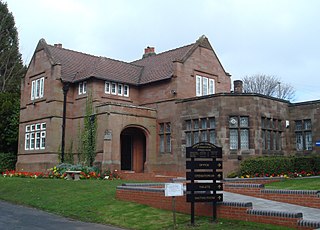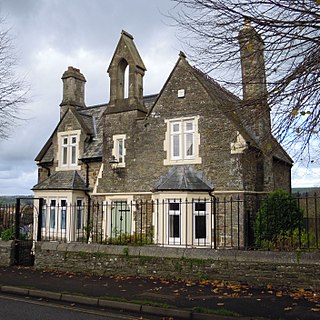
Welford Road Cemetery is a public cemetery in Leicester, England.

Welford Road Cemetery is a public cemetery in Leicester, England.
The Leicester General Cemetery Company was founded in 1845, and the cemetery itself opened in 1849. [1] The buildings and plan of the cemetery were designed by J. R. Hamilton and J. M. Medland, who also designed cemeteries for Birmingham and Plymouth. [1] Welford Road Cemetery was initially intended for dissenters, but the local Anglican community was able to gain inclusion. The site was initially 17 acres (6.9 ha) in size, but was extended by 13 acres (5.3 ha) in 1894. [1]
The original parts of the cemetery were built to a symmetrical plan. Two adjacent chapels were built, serving both Anglicans and non-Anglicans. [2] Similarly, the original cemetery contained roughly equal areas of consecrated and unconsecrated ground.
The two chapels have now been demolished, as has a gothic lodge near the main entrance. [2] The gardener's lodge survives as the University of Leicester chaplaincy, and the ornate 1895 entrance gates are still in place. A modern visitor's centre is located near the cemetery's main entrance. [2]
The cemetery contains over 300 British Commonwealth war graves, cared for by the Commonwealth War Graves Commission (CWGC), 286 from the First World War (more than half of these in a war graves plot where a Screen Wall memorial lists names of those buried in it) and 46 from the Second, beside graves of 8 Belgian servicemen (one unidentified). [3] It also has a war memorial which includes a statue designed by Sir Reginald Blomfield. [4]
A leaflet published by Leicester City Council identifies one hundred notable burials within the cemetery. The cemetery itself contains a large number of commemorative plaques, giving biographical information about notable interments. [5]

Between 2002 and 2004 about 1000 memorials and headstones were laid flat after Leicester City Council 'topple-tested' them for stability. Initially unaware that they needed to obtain a faculty to authorise this in the consecrated ground, the council applied for a faculty retrospectively, although they were opposed in this by relatives of 119 Polish descendants whose relatives' memorials had been laid flat. At first the Consistory Court rejected the Council's application, but this was subsequently granted on appeal to the Court of Arches in 2006. However, in granting the faculty the Court required the Council to work with the Friends of Welford Road Cemetery and members of the local Polish community to restore those flattened memorials. [6]

Coalville is a town and unparished area in the district of North West Leicestershire, Leicestershire in the East Midlands of England, with a population at the 2011 census of 34,575. It lies on the A511 trunk road between Leicester and Burton upon Trent, close to junction 22 of the M1 motorway where the A511 meets the A50 between Ashby-de-la-Zouch and Leicester. It borders the upland area of Charnwood Forest to the east of the town.

West Norwood Cemetery is a 40-acre (16 ha) rural cemetery in West Norwood in London, England. It was also known as the South Metropolitan Cemetery. One of the first private landscaped cemeteries in London, it is one of the "Magnificent Seven" cemeteries of London, and is a site of major historical, architectural and ecological interest.

Tower Hamlets Cemetery Park is a local nature reserve and historic cemetery in the London Borough of Tower Hamlets within the East End of London. It is regarded as one of the seven great cemeteries of the Victorian era.

Nunhead Cemetery is one of the Magnificent Seven cemeteries in London, England. It is perhaps the least famous and celebrated of them. The cemetery is located in Nunhead in the London Borough of Southwark and was originally known as All Saints' Cemetery. Nunhead Cemetery was consecrated in 1840 and opened by the London Cemetery Company. It is a Local Nature Reserve.

Anfield Cemetery, or the City of Liverpool Cemetery, is located in Anfield, a district of Liverpool, Merseyside, England. It lies to the northeast of Stanley Park, and is bounded by Walton Lane to the west, Priory Road to the south, a railway line to the north, and the gardens of houses on Ince Avenue to the east. The cemetery grounds are included in the National Register of Historic Parks and Gardens at Grade II*.

Toxteth Park Cemetery is a graveyard on Smithdown Road, Liverpool, United Kingdom. It was opened on Monday 9 June 1856. It was the responsibility of the Toxteth Park Burial Board, which had been established by at least 1855.

Undercliffe Cemetery is located between Otley Road and Undercliffe Lane in the Bolton and Undercliffe ward, Bradford, West Yorkshire, England. The cemetery stands atop a hillside overlooking the city and contains some very impressive Victorian funerary monuments in a variety of styles. It is a notable example of a Victorian cemetery where a number of rich and prominent local residents have been buried, notably mill owners and former mayors. Undercliffe Cemetery is grade II* listed by English Heritage in their Register of Parks and Gardens of Special Historic Interest in England.

Lodge Hill Cemetery is a municipal cemetery and crematorium in Selly Oak, Birmingham, England. The cemetery was first opened by King’s Norton Rural District Council in 1895, and during the 1930s became the site of Birmingham's first municipal crematorium.

The cemetery has had various titles including The Cemetery by the Common, Hill Lane Cemetery and is currently known as Southampton Old Cemetery. An Act of Parliament was required in 1843 to acquire the land from Southampton Common. It covers an area of 27 acres (11 ha) and the total number of burials is estimated at 116,800. Currently there are 6 to 8 burials a year to existing family plots.

Layton cemetery is a graveyard located at Talbot Road in Blackpool, Lancashire in England. It was opened in 1873 when Blackpool parish church was replete with burying. The site encompasses 30 acres (120,000 m2), having been regularly expanded during its history. It is administered by Blackpool Council. A number of memorials in the cemetery are executed in Portland stone.

Queen's Road Cemetery is a cemetery in Croydon, England. It opened in 1861, and was followed in 1897 by the larger Croydon Cemetery in Mitcham Road. Both cemeteries are now managed by the London Borough of Croydon.

Southern Cemetery is a large municipal cemetery in Chorlton-cum-Hardy, Manchester, England, 3 miles (4.8 km) south of the city centre. It opened in 1879 and is owned and administered by Manchester City Council. It is the largest municipal cemetery in the United Kingdom and the second largest in Europe.

The City of London Cemetery and Crematorium is a cemetery and crematorium in the east of London. It is owned and operated by the City of London Corporation. It is designated Grade I on the Historic England National Register of Historic Parks and Gardens.

Reading Old Cemetery is in the east of Reading, Berkshire, England. It is located immediately to the east of Cemetery Junction, a major road junction in Reading. The cemetery is Grade II listed.

The English coastal city of Brighton and Hove, made up of the formerly separate Boroughs of Brighton and Hove in East Sussex, has a wide range of cemeteries throughout its urban area. Many were established in the mid-19th century, a time in which the Victorian "cult of death" encouraged extravagant, expensive memorials set in carefully cultivated landscapes which were even recommended as tourist attractions. Some of the largest, such as the Extra Mural Cemetery and the Brighton and Preston Cemetery, were set in particularly impressive natural landscapes. Brighton and Hove City Council, the local authority responsible for public services in the city, manages seven cemeteries, one of which also has the city's main crematorium. An eighth cemetery and a second crematorium are owned by a private company. Many cemeteries are full and no longer accept new burials. The council maintains administrative offices and a mortuary at the Woodvale Cemetery, and employs a coroner and support staff.

St Woolos Cemetery is the main cemetery in the city of Newport, Wales situated one mile to the west of the Church in Wales cathedral known by the same name. It contains four chapels, and various ornate memorials dating back to the early Victorian period, and was the first municipally constructed cemetery in England and Wales. It remains in use to this present day as the main cemetery for burials in Newport, and has been used as a filming location for the BBC series, Doctor Who. The cemetery is listed on the Cadw/ICOMOS Register of Parks and Gardens of Special Historic Interest in Wales.

London Road Cemetery is a 17-hectare (42-acre) cemetery in Coventry, England, designed by Joseph Paxton and opened in 1847.

Earlham Road Cemetery, Norwich also known as Earlham Cemetery or Norwich Cemetery is a cemetery located in Norwich which was officially opened on 6 March 1856 and covers 34 acres (14 ha). The cemetery is divided into two distinct sites by Farrow Road A140 which runs north–south across the site. To the east of the road is the original 19th century cemetery and to the west of the road lies the 20th century addition. Today, it caters for all faiths with separate burial grounds and chapels for Jews and Catholics and a growing one for Muslims together with two military cemeteries. The 19th century cemetery is designed with an informal garden cemetery layout with winding paths while the remainder is a more formal grid type which was favoured by cemetery designer John Claudius Loudon. Much of the original cemetery is a County Wildlife Site and contains grassland and a wide selection of mature trees.

Barnstaple Cemetery is the burial ground for the town of Barnstaple in Devon and is managed by North Devon Council.

Nottingham Road Cemetery is a municipal cemetery in Chaddesden, an inner suburb of Derby, in central England. It was established in 1855 to provide more more burial capacity for the rapidly growing town.
![]() Media related to Welford Road Cemetery at Wikimedia Commons
Media related to Welford Road Cemetery at Wikimedia Commons